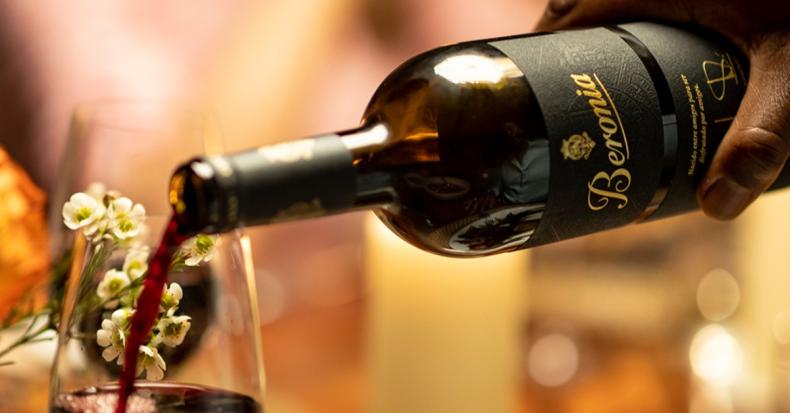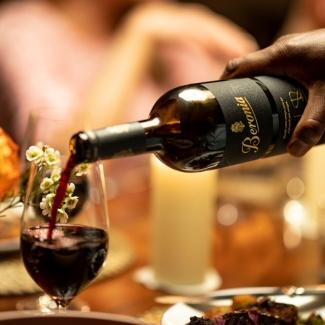Rioja is a wonderfully versatile wine. Equally at home as a solo sipper or as a partner to foods as varied as seafood or smoked fish for white Rioja and rosé Rioja, to roasted meats and cheese for red Rioja, it’s truly a wine for all occasions and most cuisine.
But how long can Rioja be kept for? How should Rioja be stored? What are the best Rioja vintages to serve? And what are the best Rioja food and wine pairings? These are all frequently asked questions about the wines of Rioja and so here are our answers to them:
How to choose a good Rioja? When choosing the right Rioja there are several things you should consider:
When are you looking to drink it? Around 98% of wines are drunk within 48 hours of being purchased and the vast majority of Riojas are released by producers when they are ready to drink. Some – especially Reserva and Gran Reserva Riojas – will develop beautifully over the coming years – but even these will be great on release, albeit they will benefit from being allowed to breathe or from being decanted.
Take Beronia’s Rioja range as an example. The Beronia Rioja Crianza is drinking brilliantly now, this medium-bodied wine offers plenty of juicy red and black berry fruits, creamy, spicy oak, and touches of cherry. This is at its peak now and will drink well for another 3-5 years. This is a great everyday drinking Rioja that will partner everything from pasta in a tomato and basil sauce to sausages and mash.
The Beronia Rioja Reserva is an altogether bigger, richer, and more complex wine. Benefiting from the outstanding Rioja vintage, there are black fruits aplenty, earthy spices and noticeable, but well-integrated vanilla oak. The extra power and extract mean this benefits from being allowed to breathe for a couple of hours before serving and will develop over the coming decade. It has the power to stand up to complex, powerful dishes such as roast red meats – even venison – or strong cheeses.
When you get to the Beronia Gran Reserva, you are talking about a fine wine that’s made for special occasions. Many people expect Gran Reservas to be even more powerful than their Reserva Rioja sibling. This isn’t usually the case, though. While Gran Reservas are made from the finest grapes in exceptional years, the extended oak ageing and time in the bottle before release means they are more about nuance, complexity, and depth than power. The Beronia Gran Reserva is wonderfully fragrant, offering a smoky, blueberry and black berry nose that’s evocative of autumn. The palate’s broad and full, yet mellow and rich, with layer upon layer of fruit mingling with notes of chocolate, herbs, and mocha. While the Reserva has the youthful vigour to match even powerful dishes, the Gran Reserva demands (and deserves) finer fare. The Sunday roast, pan-fried lamb, roasted pumpkin soup with sourdough toast, or lentil and bean roulade with blue cheese sauce. The Beronia Gran Reserva will cellar well for many years, becoming softer, lighter, and slightly fresher, while maintaining its mellow character.
What food are you looking to drink your Rioja with? – as we’ve mentioned above, different red Rioja wines will suit different cuisines. When it comes to rosé and white Rioja, these are best suited to white meats, poultry, seafood, or salads.
Are you a traditionalist or a modernist Rioja wine lover? – as you get to know Rioja producers, you’ll learn that they (roughly) fall into two camps; modern and traditional. Modern producers tend to use less oak and look for slightly less extraction, so their wines are fresher, fruitier, and lighter. Traditional producers – like Bodegas Beronia – use the latest winemaking techniques but adhere to traditional methods too. Their wines are often fuller, and spicier, and have a notable buttery, vanilla signature to them.
How should you store Rioja? If you are thinking of ageing Rioja – or ‘laying it down’ – there are some things you should do. First off, lay it on its side to prevent the cork from drying out. Secondly, try and store it somewhere cool and dark. While most of us don’t have the luxury of a subterranean cellar, houses or garages have a cooler, darker spot in which robust wines like Rioja will age well in. Thirdly, find somewhere where the temperature is as constant as possible and as free from vibration as possible.
Which Rioja wines are worth ageing? While Crianza wines from great producers in great years can age well, if you’re looking to age Rioja look to the Reserva, Gran Reserva wines as well as varietal (single grape) Riojas made from vines such as Mazuelo and Graciano. These wines tend to only be made in exceptional years and, in the case of Reserva and Gran Reserva wines, the extended oak ageing imparts a longevity that isn’t found in other wines.
How well does Rioja age? The short answer is very well indeed. The longer answer is a little more complicated… Rioja’s wines can age and develop for many decades. Reserva and Gran Reserva Red Riojas from great vintages such as 2005, 2010, 2015, 2016, 2019, or 2020 from leading producers such as Beronia can age and develop over many, many years. Great older vintages such as 1978 or 1982 are still drinking well to this day. Over time they tend to lose colour and the fruity intensity of youth and develop co-called ‘tertiary’ notes. In red Riojas, these often have bouquets with notes of dried flowers and preserved red fruits, while on the palate they offer subtle, smoked berry and dried cherry tones.
White and rosé Riojas are generally best drunk while the fruit is fresh and lively. More serious examples such as the Alegra de Beronia rosé can improve further with a couple of years of cellarage though.
How does Rioja’s ageing potential compare to other great wine regions? Red Rioja is one of the longest-lived wines in the world. Stored properly, a great wine from a great vintage can easily last fifty years or more. Rioja can age longer than red Burgundy and can easily age for as long as the best wines of Bordeaux or the Rhône.
What temperature should Rioja be served at?
Obviously, this will depend on whether it’s a rosé, white or red Rioja. The following are our suggested serving temperatures:
White Rioja – between 6 and 8 degrees centigrade.
Rosé Rioja – between 6 and 8 degrees centigrade.
Red Rioja - between 14 and 16 degrees centigrade.
In the case of old red Riojas - ones that are ten or so years past their vintage – serving them slightly cooler seems to suit them better.
Does Rioja need decanting? Decanting wine – pouring from the bottle into a decanter – will aerate the wine and help bring out the flavour. As wines age they can develop a sediment as dissolved compounds in the wine solidify. These are harmless but not pleasant, and decanting is a good way of getting rid of them. Generally decanting – like letting wines breathe – is a good idea, but most Riojas don’t need to be decanted.
‘What does letting a wine breathe’ mean and how does letting a Rioja breathe improve it? Letting a wine breathe simply means removing the cork from the bottle and letting it stand open for a while before serving. For the best results, pour a glass out of the bottle. This will give the remaining wine more contact with the air. In terms of how long you should let it breathe, that will depend on the age/maturity of the wine. For young wines, say the Beronia Crianza, a couple of hours will allow it to open up beautifully. If you are fortunate enough to get hold of something like a Beronia Gran Reserva Rioja, then an hour should be sufficient.
Letting a Rioja breathe improves the wine by helping to release a wine’s aromatics – which is why you swirl wine in the glass. While the palate may lead the way when tasting wine, the nose has a huge part to play and opening up a wine’s aromatics can significantly increase the pleasure you derive from it. Try tasting a wine when holding your nose and you’ll see what we mean.
When wines breathe, they also release other characteristics, soften the tannins, and can ‘wake up’ the wine. Young and old wines often need waking up, but in the case of very old Riojas – those twenty years or more past their release date – breathing can lead them to fade. For these very old wines, it’s often better to let them breathe in the glass.
How long does a bottle of Rioja last once opened? That will depend on a number of things – how much wine is left in the bottle, if the bottle is kept somewhere cool, if the cork is left in it or if a wine stopper is used, if it’s a white or red Rioja. When making white wines, more sulphur dioxide is used and this can give the wine a longer shelf life once opened. Red Riojas – especially young Reserva and Gran Reserva wines – can actually improve over twenty-four hours or so. As a rule of thumb, a half bottle of white Rioja left in the fridge with the cork in will be good for 72 hours or so. The equivalent red Rioja is usually good for 48 hours.
What food and wine pairings work well with Rioja? Rioja is an extremely food-friendly wine. Whether you’re looking for something fresh and fruity to enliven a crisp summer salad, a rosé to bring out the best in pink fish or roasted poultry, or a rollicking good red to serve with the Sunday roast, Rioja has the perfect wine for you. You can find some fantastic food and wine matches in our recipes section, but the following offers a quick overview of food and Rioja matches:
White Rioja – a modern style of white Rioja, such as the Beronia Viura – with its bright, fresh fruit and tangy acidity is ideal with white meats, green salads, tapenade and crusty bread, seafood, and pork.
Rosé Rioja – a lighter, zestier style of Rosé Rioja like the Beronia Rosé is a joy with dishes such as chicken Caesar salad, mushroom risotto, bean and herb salad, grilled fish, or roasted poultry. A more serious, weightier Rioja Rosé such as the wonderfully plump, generously fruited Alegra de Beronia can stand up to more complex dishes. Tuna tartare, lamb cutlets, roast guinea fowl, salmon en croute, all these work wonderfully well.
Red Rioja – young red Riojas such as the Beronia Crianza with its abundant red and black fruits and palate-popping energy are great with tomato pasta, pizza, meatballs, and creamy cheese flans. Wines like the Beronia Reserva with a rich seam of smoky, creamy oak and mellow fruity tones go brilliantly with pan-fried steak, mushroom stroganoff, crumbly cheeses, and slow-cooked lamb shanks. Rare and luxurious Gran Reserva Rioja is a wine to serve with suitably special foods. Fine, air-dried cooked meats, artichoke roulade, Sunday roast, fine pâte, or a cheeseboard.
What are the best vintages for Rioja? As rosé and white Rioja aren’t generally designed for long cellaring, we’ll stick to red Rioja vintages. The best recent years include: 2021, 2020, 2019, 2016, 2015, 2011, 2010, 2005, 2004, and 2001.
Enjoyed reading this blog? Find more interesting and educational blogs here.




